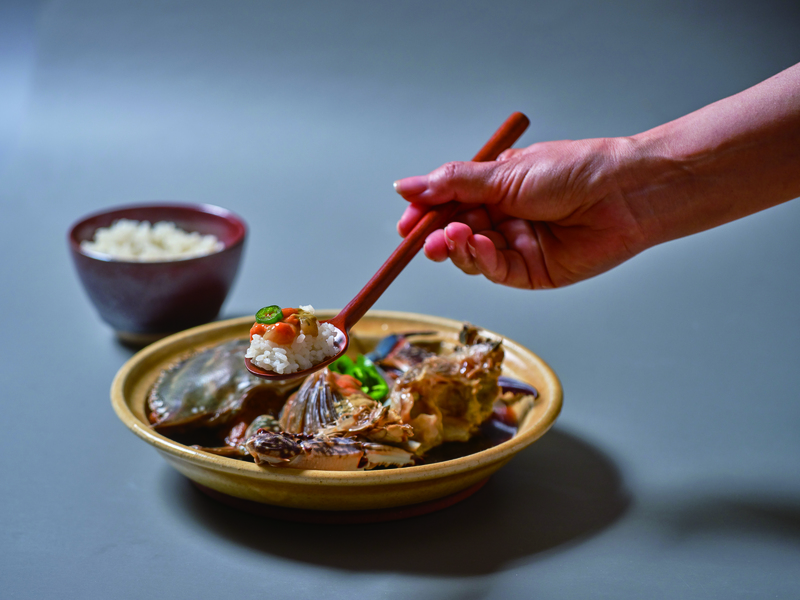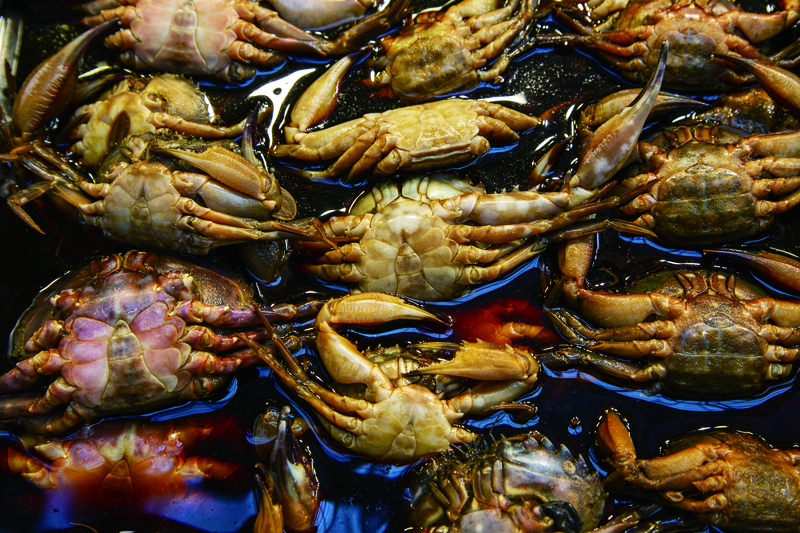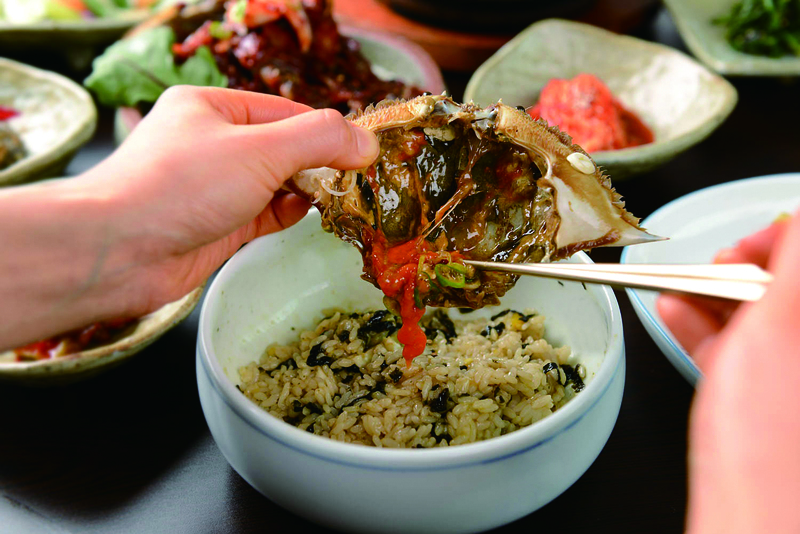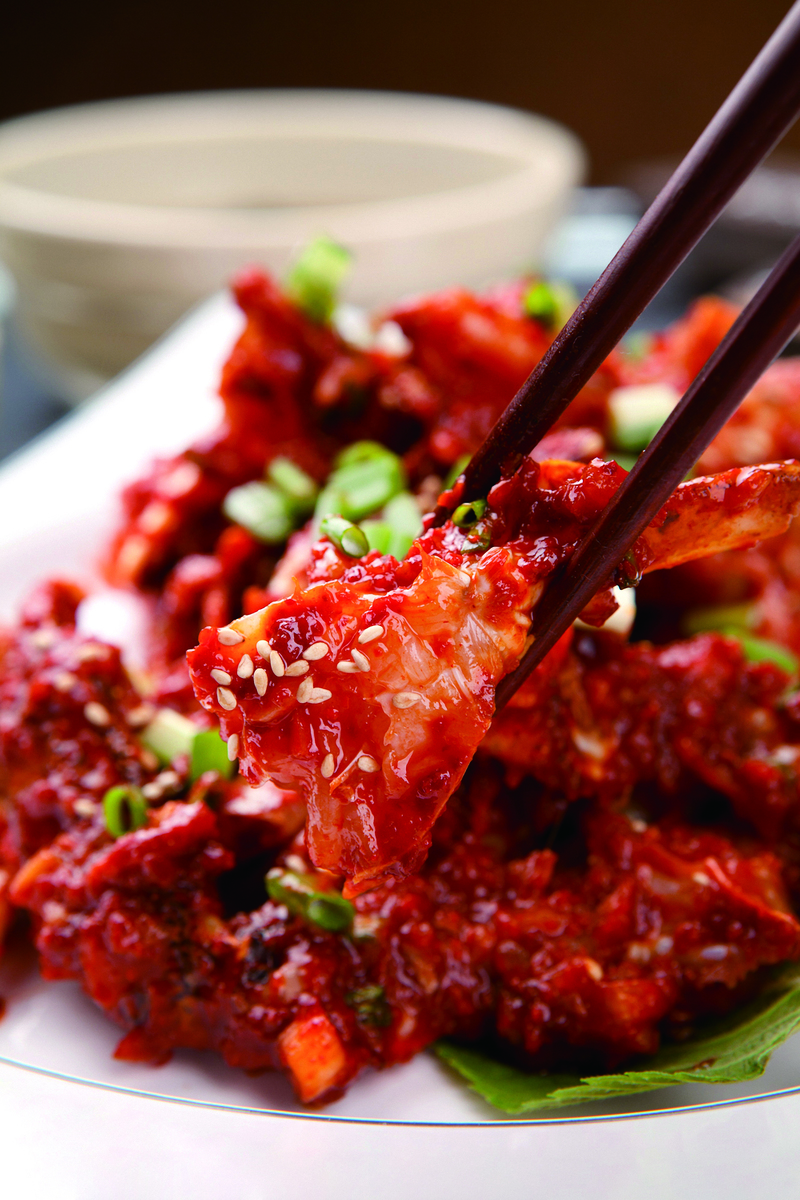The soft flesh underneath the hard shell is so tender that it melts in the mouth. The delicate and juicy meat, along with the crab’s innards, oozes right out upon first bite, with the initial salty and spicy kick instantly yielding to a mild sweetness that envelopes the entire palate. How could anyone dislike such a delightful combination of flavors? Allow me to introduce you to the traditional Korean dish gejang.

Ganjang gejang is a dish of fresh crab marinated in a mix of soy sauce, onion, garlic, and other ingredients. The crab’s delicious, chewy flesh combined with its soft and creamy innards make this dish truly irresistible.
The term “jang” in “gejang” stems from the Chinese character 醬, which refers to a variety of sauces and pastes made from fermented soybeans. Some of the better-known examples include ganjang, or soy sauce, doenjang, also known as soybean paste, and gochujang, a spicy red pepper paste that has lately found its way into international fusion cuisine. All of these condiments are made from bricks of dried fermented soybeans called meju, which are soaked in brine for an extended period in order to undergo secondary fermentation. Soy sauce is produced by filtering and boiling the liquid obtained from the fermented meju and brine mixture.
BORN OUT OF TRADITION
The process of preparing ganjang gejang, namely soaking raw crab in a soy sauce marinade for a significant length of time, draws many similarities with Korea’s culinary tradition of fermentation, which involves aging certain foods to enhance their flavor. There is also a spicy variation of this dish called yangnyeom gejang, in which the marinade is primarily made from gochujang and soy sauce.
To fully appreciate gejang, it is necessary to have a basic understanding of the cultural significance of jang in Korean cuisine. The use of soy sauce to marinate fresh crabs for ganjang gejang, or gochujang and soy sauce, along with various other ingredients, to make the sweet and savory yangnyeom gejang marinade, is deeply rooted in the culinary tradition of jang which itself plays an integral role in Korean cuisine as a whole.
GOOD SOY SAUCE AND FRESH CRABS

Although ganjang gejang was traditionally made using live crabs, these days the dish is prepared using flash-frozen crabs that are harvested during peak season.
© gettyimagesKOREA
Gejang can be broadly divided into two types: ganjang gejang and yangnyeom gejang. As mentioned above, ganjang gejang is made by submerging raw crabs in soy sauce and allowing them to marinate in a refrigerator for a few days. The key to tasty ganjang gejang is the use of fresh crabs and high-quality soy sauce. Hence, handmade soy sauces are recommended over store-bought ones. This is because soy sauce is a product of fermentation, and the aging process has a direct impact on the product’s flavor and salinity concentration. Traditionally made soy sauce, or
ssiganjang, is fermented for an extensive period of time, which gives it a superior taste. To make ganjang gejang, finely sliced onions, scallions, apples, garlic, and chili peppers are mixed with ssiganjang before being brought to a boil and left to cool down. Fresh crabs are then added to the cooled soy sauce mixture and left to marinate in the refrigerator for a few days before serving.
The most traditional method of preparing gejang involves submerging live crabs in ssiganjang along with small pieces of beef inside a large earthenware jar. Over the next few days, the crabs consume the meat. This process is said to give them a much sweeter taste as well as a tender texture.
Nowadays, instead of feeding beef to the crabs, it is more common, when boiling the sauce, to add sugar or corn starch syrup along with rice cooking wine to achieve the sweet flavor. Gejang is typically marinated for two to three days, but leaving it for longer allows the soy sauce to penetrate the crabs deeper and more evenly, which results in a more intense flavor.
HOW TO EAT GANJANG GEJANG

One of the most popular ways of enjoying ganjang gejang involves filling the crab’s shell with rice which is then mixed with the marinated innards to make gettakji bap.
© gettyimagesKOREA
Before the perfectly marinated flesh under the crabs’ hard exterior can be enjoyed, the outer shells must be removed. Once this is done, the crabs should be cut in half with a pair of scissors. One can then squeeze the pieces to extract all the juicy flesh which oozes with the marinade and the crabs’ bright orange innards. Added to a spoonful of freshly cooked rice, this delightful combination bursts with savory goodness.
This process is just the start. After the first mouthful of ganjang gejang, it is time to get down to the serious business. Inside the carefully removed outer shells, one finds the savory and creamy innards, the most prized part of the dish. A common practice involves filling the shells with rice and mixing it with the marinated innards to make
gettakji bap, literally “crab shell rice.” Another popular way of enjoying the innards is by mixing them with crab meat, roasted sesame oil (a staple of Korean cuisine which boasts an exquisitely nutty flavor), dried laver, and rice to make gejang bibimbap. Some restaurants will even top this off with some flying fish roe which adds a crunchy pop of texture to the dish.
Although the soy sauce marinade is certainly important, the key to preparing this dish lies in ensuring the crabs’ flesh is soft and their innards savory, which requires the use of fresh in-season crab. The coastal area near Seosan in South Chungcheong Province is known for its abundance of blue crabs; crabs caught in season, especially egg-carrying female crabs, make for the best-tasting ganjang gejang.
FROM GEJANG TO GANJANG GEJANG

Known for its sweet and spicy sauce, yangnyeom gejang finds its origins in mixed and seasoned dishes known as muchim. In contrast to the equally popular ganjang gejang, in which the crab is first marinated, yangnyeom gejang is meant to be eaten right away.
© gettyimagesKOREA
Although the term “gejang” used to be synonymous with ganjang gejang, this changed with the arrival of yangnyeom gejang, a dish consisting of crabs coated in a red sauce with a completely different flavor profile and appeal.
Yangnyeom gejang has a shorter history than its predecessor. Its origins can be traced back to the Chungcheong and Jeolla provinces, which have a long-standing tradition of mixing raw fish or dried pollock with a spicy sauce made from either red pepper flakes or gochujang. People later began eating crab in the same fashion, which resulted in the dish known today as yangnyeom gejang. At the time, the dish was simply referred to as
ge muchim. “
Muchim” is a term widely used in Korean cuisine to refer to dishes made from ingredients dressed in a spicy sauce, including the likes of
hoe muchim (raw fish salad) and
hwangtae muchim (pollock salad).
Yangnyeom gejang differs from ganjang gejang in many ways. While ganjang gejang is made by marinating crabs in soy sauce, yangnyeom gejang involves simply dressing crabs in a sweet and spicy sauce, and while the former is left to age, the latter is meant to be eaten right away. Unlike ganjang gejang, yangnyeom gejang isn’t meant to bring out all of the crab’s subtle flavors. Although there is no fixed recipe, the sauce is usually made from a combination of red chili powder, gochujang, soy sauce, sugar, garlic, scallions, onions, and corn starch syrup. Compared to the sauce used in the earlier version of the dish, namely ge muchim, yangnyeom gejang sauce now has a thicker and somewhat stickier consistency.
Smaller crabs are usually preferred when preparing this dish. The process involves removing the shells, gills, and abdominal flaps from the crabs, cutting them into halves or quarters, and generously coating them in the tasty sauce. Thanks to its addictively sweet and spicy flavor, yangnyeom gejang has come to rival ganjang gejang in popularity.
RESTAURANTS SPECIALIZING IN GEJANG
The popularity of gejang in Korea is evidenced by the large number of restaurants specializing in the dish. These range from upscale restaurants, where a single crab can cost over 40,000 won, to all-you-can-eat restaurants offering unlimited ganjang gejang and yangnyeom gejang from as little as 10,000 or 20,000 won per person. In the Sinsa-dong neighborhood in Seoul’s Gangnam District, there is even an entire street known as “Gejang Alley” lined with restaurants specializing in this particular dish. Although it is unclear which of these places first sold the delicacy, the restaurants in Gejang Alley are usually all full of customers.
Particularly popular among gejang lovers is Jinmi Sikdang, a restaurant located in Gongdeok-dong in Seoul’s Mapo District. This place boasts an abundance of crabs during the peak seasons in June and December. The locally fished crabs are carefully air-shipped and promptly frozen at minus 35 degrees Celsius to ensure they remain as fresh as live crabs. At this restaurant, ganjang gejang is served alongside a wide variety of side dishes, including fluffy steamed eggs called
dalgyal-jjim, a spicy stew made from crab and kimchi called
kkotge jjigae (which is sometimes referred to as
gekukji), a fermented dish of salted oysters with hot pepper powder called
eori-guljeot, and a type of dried green laver which stands out for its distinct texture and aromatic flavor. One tasty way to enjoy this dish is to wrap some rice in green laver with some eori-guljeot and crab meat. Jinmi Sikdang’s popularity is likely to soar even further, after earning a coveted spot in the 2023 Seoul MICHELIN Guide.
Hwang Hae-won Editor-in-chief, Food Service Management
Lee Min-Hee Photographer